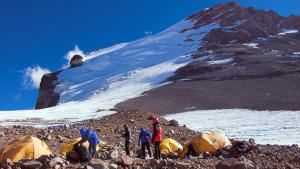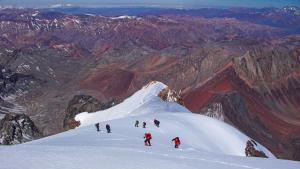|
Related Topics: |
|
|
|
Current News |
|
Chemistry A to Z |
|
About Internetchemistry |
PCB Contamination at the Summit |
|
Conception/Leipzig - The snow samples taken at an altitude of 6200 metres are among the highest traces found anywhere in the world of these substances, which have been banned since 2001. In particular, the samples contained more persistent compounds like hexachlorobiphenyl (PCB 138) and heptachlorobiphenyl (PCB 180). |
|
Mountain ranges could be a natural trap for persistent organic pollutants that are transported by the atmosphere all over the world, say the scientists from IIQAB in Barcelona (Now IDAEA), the UFZ in Leipzig and the University of Concepcion in Chile, writing in the journal Environmental Chemistry Letters. According to the researchers, these findings highlight the need to investigate further the role of mountains in the spread of these pollutants and the associated risks. Just a few weeks ago, Swiss researchers found similar persistent environmental pollutants in glacial lakes in the Alps and pointed to potential risks to drinking water supplies. Polychlorinated biphenyls (PCBs) are among the ‘dirty dozen’ persistent organic pollutants banned worldwide under the Stockholm Convention. Until the 1980s, PCBs were used primarily in transformers and capacitors and as hydraulic fluids and diluents. As well as causing chronic effects like acne, hair loss and liver damage, PCBs are also a suspected cause of male infertility. The toxin also represents a danger to a large number of animals because it accumulates in fatty tissue and is passed on via the food chain. The study of environmental pollution in remote mountain regions is difficult because they are not easily accessible. "This is compounded by the fact that the concentrations are often so small that researchers have to bring back large quantities of snow just to reach the detection limit. While conventional extraction methods need at least a litre of snow, the solvent-free method we used works with 40 ml," explains Peter Popp of the Helmholtz Centre for Environmental Research (UFZ), who analysed the samples in the laboratory in Leipzig. Roberto Quiroz of IIQAB, the Spanish research institute for environmental chemistry (now researcher at the EULA Chile Environmental Sciences Centre), adds, "On expeditions to high mountain peaks, every gram counts. We would never have been able to carry 40 litres of snow per sample. So we were very pleased that only 40 ml per sample were required for analysis in Leipzig." Aconcagua is in the southern Andes, close to the Chile-Argentina border, and has five large glaciers. It was a holy mountain of the Incas. As one of the Seven Summits (the highest mountains of each of the seven continents) Aconcagua is now a popular destination for mountaineers. The first to reach the summit was Swiss mountaineer Matthias Zurbriggen in 1897. During the 2003 expedition, the Chilean researchers took samples at altitudes of 3500, 4300, 5000, 5800 and 6200 metres. The concentrations measured do not represent any immediate danger to mountaineers, who melt small quantities of snow to obtain water. The PCB concentration on Aconcagua was less than half a nanogram per litre. Compared with the values measured in other mountain and polar regions, the concentrations on the mountain peak in the Andes were relatively low. Concentrations four times higher have been measured in the Italian Alps, for instance - an indication that pollution in the southern hemisphere is less severe than in the northern hemisphere. The PCB concentrations measured around the peak of Mount Aconcagua were approximately one-tenth of those found in earlier samples taken from Sierra Velluda, a mountain just 3500 metres high on the west side of the Andes in Chile. "This could be because of the way in which these pollutants accumulate in the snow. But it could also have something to do with the three hydroelectric power stations on the lower slopes of Sierra Velluda. Their transformers are potential sources of PCBs," suggests Ricardo Barra of the EULA-Chile Centre for Environmental Research at Concepcion University. "However, detecting PCBs in the snow on top of Aconcagua clearly shows that these compounds are transported to the Andes by the atmosphere and accumulate there." The research findings are also relevant in relation to climate change: "The shrinking of the glaciers could lead to the pollutants stored in the glacier snow being carried down with the melt water," fears Roberto Quiroz. South America is not the only part of the world in which water from melting glaciers plays an important role in irrigation for farming and as a source of drinking water. [Tilo Arnhold] |
|
|
|


